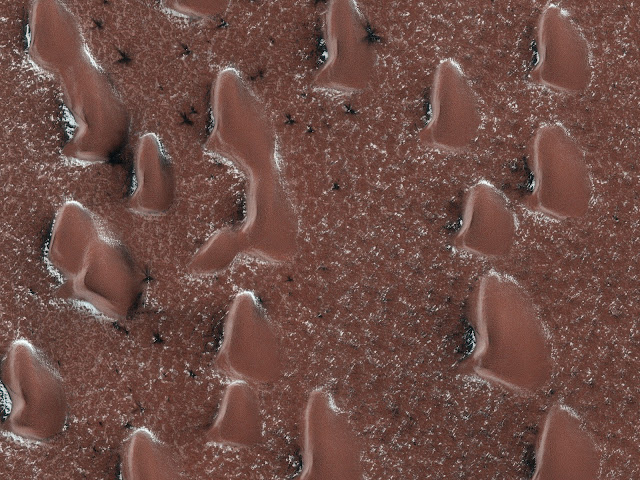"Spring Sprouts" of The Martian North | NASA Mars Reconnaissance Orbiter
The sun is rising in Mars’ Northern Hemisphere, and spring activity is starting as the seasonal polar cap begins to sublimate (going from ice directly to gas). A layer of dry ice covers the sand dunes in this image.
Gas jets sprout through the ice layer carrying dust and sand from the surface, showing up as dark fans. At this time in early Martian spring, the fans are visible between the sand dunes. The ground between the dunes is on the scale of tens of centimeters, and ice in places where the sun hits more directly will thin fastest, releasing the jets. Later, the ice over and around the dunes will rupture and more fans will appear on the dunes.
This image was acquired on December 24, 2020, by NASA's Mars Reconnaissance Orbiter (MRO) at an altitude of 271 km from the planet's surface. The image is less than 1 km across.
The University of Arizona, Tucson, operates the High Resolution Imaging Science Experiment (HiRISE) instrument, which was built by Ball Aerospace & Technologies Corp., Boulder, Colorado.
NASA's Jet Propulsion Laboratory, a division of Caltech in Pasadena, California, manages the Mars Reconnaissance Orbiter Project for NASA's Science Mission Directorate, Washington.
“For 17 years, MRO has been revealing Mars to us as no one had seen it before,” said the mission’s project scientist, Rich Zurek of JPL.
Image Credit: NASA/JPL-Caltech/University of Arizona
Caption Credit: Candy Hansen
Image Date: Dec. 24, 2020
#NASA #Space #Astronomy #Mars #Planet #RedPlanet #Science #Geology #Landscape #Terrain #Geoscience #NorthernHemisphere #SandDunes #GasJets #DarkFans #MRO #Orbiter #Spacecraft #HiRISE #HiRISECamera #JPL #Caltech #UniversityOfArizona #BallAerospace #STEM #Education

No comments:
Post a Comment